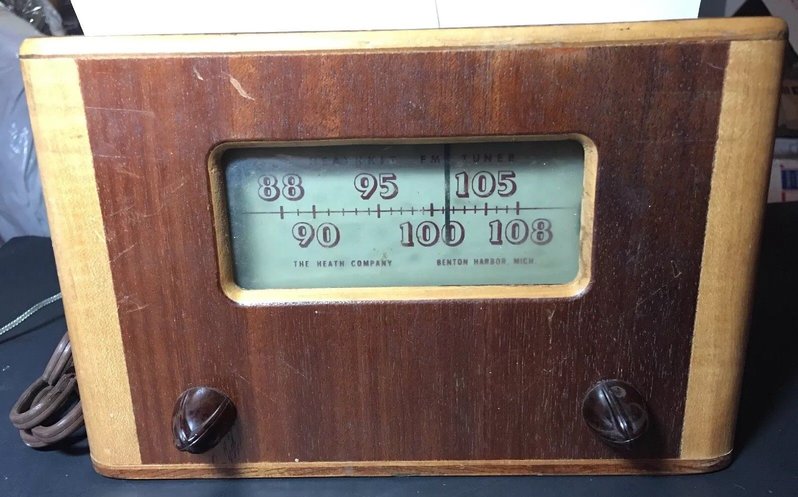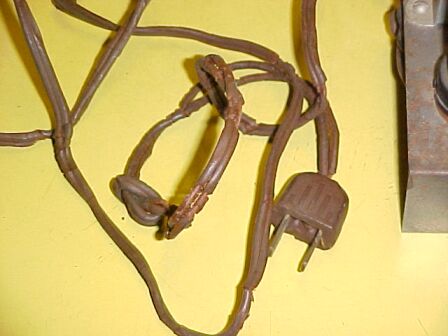

The Heathkit FM tuner, model FM1, is a
kit version of a Fremodyne receiver, unlike the Meck
CX500 which was sold as a built up unit. At this point, unless you've
come to this page from there, I suggest reading my Fremodyne
article to acquaint yourself with this novel kind of receiver.
During the late 1940's with the new FM
stations appearing all over the U.S, and with few people owning expensive
FM sets, the FM converter was seen as a low cost way to be able to listen
to FM. These FM converters are simply an FM receiver providing a line level
audio output. Today, they'd be called a "tuner" rather than a "converter".
The idea was you could "convert" your AM set by feeding one of these devices
into its pickup terminals.

This ad was one of many in the U.S electronics magazines around
1949. Unfortunately mine does not have the cabinet.

This example with cabinet showed up on ebay.

As can be seen from the circuit, it follows
the standard Fremodyne design. However, instead of multi turn coils for
the aerial input and local oscillator, a large single turn coil is used
instead. It appears Heathkit provided these coils to eliminate the need
for alignment instruments on part of the home constructor.
A transformer power supply is used which
is nice to see compared with the usual live chassis Fremodyne set. As Heathkit
liked to use war surplus parts in their kits to lower the cost, we can
see a 12A6 used for the rectifier. It's an audio output pentode with 12.6V
heater that was used in military equipment. By strapping all the grids
to the plate, the valve can be used as a diode. Like the Meck FM converters,
a 14F8 is used for the local oscillator and 21.75Mc/s super regenerative
detector. It's the loctal version of 12AT7. More of the manual is here.

The mains lead on my Heathkit. And, yes I did plug it in and use
it like that. The rubber has hardened and crumbled but the wire underneath
is still covered by what appears to be cotton and wasn't shorting together
anywhere. Besides, it was run from a double wound stepdown transformer.
Like my other Fremodyne receivers, this one came from eBay. It wasn't in the best of condition with the dial pointer missing and a dent in the IF coil can. The mains lead was somewhat perished but that's hardly surprising given its age. The dial itself has a few blemishes where the paint has come away from the aluminium beneath. I made up a replacement pointer from brass.

Back of chassis with audio output terminals to the left and aerial
terminals to the right. Like most Fremodyne receivers, the designers seem
to expect balanced transmission line to be connected to the aerial terminals,
despite being an unbalanced input. Notice the dented IF coil can.
I plugged the tuner into one of my 240-120V stepdown transformer just to see if any audio would be forthcoming before I got around to restoring it. Well, there certainly was and several stations were received. It behaved just like the other Fremodyne sets, the performance of which I've described in greater detail in other parts of this site. The audio quality wasn't as good as it should be but again I was expecting that knowing that not all the components were 100%. I was pleased that the electrolytic filter condenser was ok as no hum was evident. Actually, I think this must be the first Fremodyne where the filter condensers have been good.

Under the chassis, all is original. Note the two VHF single turn
coils.
At this point in time the receiver is not
restored. I do have ideas about making a cabinet for it, and maybe even
restoring the dial.
The kit was discontinued in 1950 as and
replaced by Heathkit's FM2 which proclaimed to have "True FM" as if to
admit there was something inferior about its predecessor. Actually, the
FM1 would have been the last of the Fremodyne receivers to be produced
as by 1950 any type of super regenerative receiver was considered obsolete
for FM reception.
*Interestingly, the last two images above were poached from this article by the well known radiomuseum site without any acknowledgement. Watch out if you have radios on your site - they too could appear there.